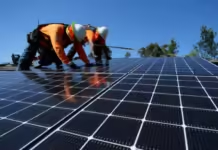Originally posted in The Business Standard on 15 December 2021
The government aims at importing 15 million tonnes per annum LNG by 2025

Bangladesh is likely to achieve the capacity of importing only 3.8 million tonnes of liquefied natural gas (LNG) per annum by 2025 with the proposed LNG facilities, which is only 25% of the target of 15 million tonnes, says the Institute for Energy Economics and Financial Analysis.
Based on its latest study, the global energy research institute on Wednesday said the country might fail to build up around 75% of the targeted capacity due mainly to financial market constraints.
It also said the country would be capable of generating 3.1-gigawatt yearly power from the gas-fired plants against the 9.1-gigawatt target by 2025 – a gap of 66%.
The study report also forecasted that only 33% of the proposed LNG investments in the country would be feasible.
Titled ‘Examining Cracking in Emerging Asia’s LNG-to-Power Value Chain’, the study made project-by-project and country-level analysis of seven emerging Asian markets — Myanmar, Bangladesh, Philippines, Vietnam, Thailand and Pakistan.
Bangladesh, earlier, announced plans to build LNG terminals having the capacity of supplying 15 million tonnes per annum along with 9135-megawatt power yearly by 2025.
However, the IEEFA forecasted only LNG terminals having the capacity of 3.8 million tonnes and 3,135MW would be feasible.
The study mentioned some key project risks in Bangladesh. Rising gas and power subsidies increase default risks within the LNG-to-power value chain, it observes, adding that low regulated tariffs put an increasing financial strain on state-owned enterprises, and generation overcapacity, renewables deployment threaten thermal power plant utilisation.
Besides, inadequate grid infrastructure exacerbates thermal plant underutilisation and new LNG import terminals will require significant gas pipeline investments, it adds.
“Over the past two years, spot market prices for LNG in Asia have hit all-time lows, followed by record highs. These wild price swings have demonstrated – perhaps more clearly than ever before – the immense challenges that highly volatile, US dollar-denominated LNG markets present for nearly every emerging Asian energy market,” the report co-author Sam Reynolds says on overall the emerging Asian economies’ challenges.
“Still, the LNG industry’s excitement around perceived opportunities in the region has spawned an unrealistic pipeline of proposed LNG projects at various stages of development.
“This is overpromising and underdelivering on a regional scale. Fundamental project, country, and financial market constraints in emerging Asia are likely to significantly reduce the pipeline of feasible LNG-related projects and prevent rapid, sustained growth in regional LNG demand.”
Currently, Bangladesh imports LNG through two floating storage regasification units, located in Moheshkhali having the capacity of supplying 3.7 million tonnes output.






